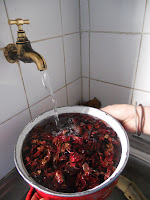I've had a few people indicate interest in traditional African recipes, so I’ve started to collect a small database comprised of my most favorite or easily made dishes. Recently, I had a guest whose family back home was looking for the “how-to” on bissap juice.
It happens to be one of my favorite drinks here in Senegal, so we made a batch and I promised to pass on the details. Bissap is known in English as Roselle, and is a close relative of the hibiscus flower. The plant is prevalent all over West and North Africa, but seems to be attainable throughout the world. It is either red or white- and while both are readily available red is most commonly transformed into juice. More information on can be found on Wikipedia.
It happens to be one of my favorite drinks here in Senegal, so we made a batch and I promised to pass on the details. Bissap is known in English as Roselle, and is a close relative of the hibiscus flower. The plant is prevalent all over West and North Africa, but seems to be attainable throughout the world. It is either red or white- and while both are readily available red is most commonly transformed into juice. More information on can be found on Wikipedia.
The most difficult and critical ingredient is going to be the bissap itself. A coffee can sized bucket of dried petals can be purchased in most Senegalese markets for 300 cfa (still less than $1 on a bad currency exchange day) and can be used to make several batches of delightful concoction. A buyer can order either the dried flower or the tea online from international sellers such as Alibaba.com or Tradekey.com, though I personally have yet to attempt this option. So far, I’ve not been able to confirm if the dried flower is available in the US, but your best bet would be to check out health food such as Whole Foods Markets or Trader Joe’s or import stores.
· Half a medium saucepan of dried bissap flower petals
· Handful of mint leaves
· 1 cup of sugar
· 45 grams of powdered sweetened instant flavored drink (I used Foster Clark’s Pineapple Coconut, but Foster Clark’s is only available in Africa, Europe, and the Middle East)
· Orange and/ or vanilla extracts- just a splash if you so choose
· Water
Step 2: Steeping
To begin, rinse the petals and leaves. They are often a bit dirty or dusty and it couldn’t hurt to attempt to rid your life of potential bacteria. Actually, let’s be realistic… you aren’t going to get it all out, but at least you’ll feel better for having tried. Once they’re “clean” place the petals and leaves back in the medium sized pot and fill the pot with water. Let the mixture steep for about an hour; the water will turn red as the flavor of the mint and bissap are released. Strain the juice of solids into a large bowl or bucket (that can later be easily sealed and stored in the fridge). Replace the water in the saucepan and spend 5 minutes squeezing the petals and leaves to release another round of flavor. Strain the second pot into the same container.



Once you’ve brewed the base of your juice, it’s time to add in the good stuff. Mix in sugar, brown sugar or honey to sweeten the taste. Leaving it unsweetened will resemble an iced tea which is still pretty tasty. A squeeze of lemon or lime can yield more of a julep flavor- and is my preference when I’m looking to cut my sugar intake. Stir in an instant flavored drink mix and extracts to enhance the taste. Bissap is similar to cranberry juice, so other berry or tropical flavor additives seem to work the best. Alternatively, the juice is often enjoyed with simply the extra kick provided by the mint.
Step 4: Consuming
A chilled glass is the preferred way to serve the juice! Senegalese families often consumed it as an after meal dessert and treat on holidays or special occasions. Peace Corps volunteers have been known to mix in gin to make a “gissap” drink, use with equal parts of sprite and a shot of whiskey for something only consumed when poor in college, or rum and an umbrella whilst hanging out on the beach. The bissap flower petals can also be steeped with hot water and consumed shortly after for a tea that is pretty decent at relieving any abdomen related cramp.
After your first taste, I’m sure you’ll understand why bissap juice is ranked among Senegal’s highest assets in my opinion. But there are a few potholes on the way to bliss, so please, don’t make the same mistakes I have. Mostly, you need to steer clear of excessive consumption; bissap is a natural diuretic that will kick in around the 3rd glass. If that weren’t fun enough it will also keep you wide awake (whether or not you’re running to the bathroom) if consumed late at night. Of course, should this be your desired effect, I would recommend simply chewing on a rehydrated petal… which I’m told is tasty enough.
Here’s hoping this makes it to my friend’s inquisitive mom and all those looking to taste something new… Cheers!




No comments:
Post a Comment